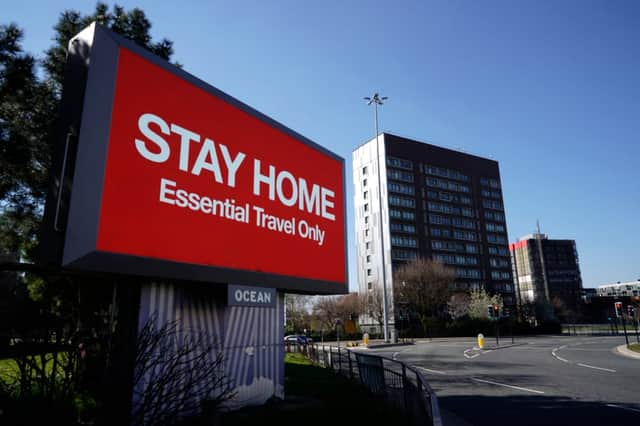These 5 things need to happen before lockdown can end in England - according to Boris Johnson


Several things need to happen before England’s lockdown can be lifted, Boris Johnson has said.
Addressing MPs on Wednesday 27 January, the prime minister set out the steps that must be met before any restrictions in the country can be eased.
Advertisement
Hide AdAdvertisement
Hide AdIt will be a “gradual and phased” exit from lockdown, which won’t happen until 8 March at least - the earliest date the government has given for the reopening of schools.
Ministers will undertake a lockdown review when Parliament returns from recess in the week beginning 22 February, and a plan for easing restrictions will be published after that.
Here’s everything you need to know about the steps that need to be met before England’s lockdown is lifted.
What needs to happen before lockdown can end?
Top four priority groups are vaccinated
The UK Government has planned to vaccinate nearly 14 million people by 15 February.
Advertisement
Hide AdAdvertisement
Hide AdThat number includes the people in the top four priority groups for the coronavirus jab.
The nine-point priority list was decided based on advice from the Joint Committee on Vaccination and Immunisation (JCVI).
The people receiving their vaccine first are the ones who have been deemed most at risk from the virus.
These groups are:
- Care home residents and staff working in care homes
- People 80 years of age and over, and frontline health and social care workers
- People 75 years of age and over
- People 70 years of age and over, and clinically extremely vulnerable individuals
The Pfizer-BioNTech and Oxford-AstraZeneca vaccines are currently being given to those priority groups in England.
Advertisement
Hide AdAdvertisement
Hide AdIf the mid-February inoculations target is reached, it is hoped that these groups will all have some immunity to Covid-19 by the time restrictions could begin to be eased on 8 March.
However, some experts have warned that relaxing most lockdown measures at the end of April - which is when all the priority groups in phase one of the vaccination programme should have been given a jab - could potentially still lead to a rise in cases.
The UK Government has set a target to vaccinate all adults in the UK by autumn.
Over 7 million people have now received their first dose of the vaccine.
R rate is reduced
Advertisement
Hide AdAdvertisement
Hide AdThe government has been relying on the all-important R number to determine how prevalent coronavirus is in the country.
It represents the infection rate - the number of people an infected person passes the virus onto.
The R rate has been shown to come down if people reduce their contacts, and it is one of the main reasons for the country being placed in lockdown.
Scientists have said that the R number must be under 1 if the virus is to be brought back under control.
Advertisement
Hide AdAdvertisement
Hide AdRight now, the R rate in the UK is estimated to be between 0.8 and 1.
NHS will not be overwhelmed
One of the other crucial reasons that the UK was placed into a fresh lockdown was due to fears that the NHS would become overwhelmed with Covid patients.
Even though restrictions have been in place since early January, Boris Johnson has said the UK remains in a “perilous situation”, as more than 37,000 patients are currently in hospital with the virus.
That number is almost double that of the peak of the first wave.
Advertisement
Hide AdAdvertisement
Hide AdFurthermore, there are more patients in ICU than at any other point of the pandemic, with 4,032 people needing ventilators to stay alive.
Nearly 3,800 people are being admitted to hospital each day.
It is thought that pressure on the NHS will remain for many weeks, until enough people have been vaccinated.
If lockdown is lifted prematurely, there’s the risk of overwhelming health services.
Deaths need to decrease
Advertisement
Hide AdAdvertisement
Hide AdAs well as hospital admissions, death rates need to fall before any lockdown restrictions are eased.
It is hoped that the vaccinations drive will help to reduce the high death rates.
The number of people dying from the virus is gradually starting to decrease, but there are still around 1,100 deaths from Covid-19 being reported each day.
Mr Johnson said that once the top priority groups have been inoculated, it will become clear whether vaccinating vulnerable people is reducing the number of people dying from the virus.
Advertisement
Hide AdAdvertisement
Hide AdProfessor Chris Whitty, England’s chief medical officer, has warned that the country is going to experience “a lot more deaths” over the next few weeks.
Positive cases must go down
Finally, positive cases must be reduced before the country can exit lockdown.
The more people that test positive for the virus, the more people end up dying with Covid-19.
Nearly 210,000 people tested positive for coronavirus in the UK in the last week, according to the 27 January figures.
Advertisement
Hide AdAdvertisement
Hide AdHowever, that is nearly 85,000 less positive cases than the previous seven days.
Professor Whitty has said that even a small change in lockdown restrictions while cases are still very high could cause an exponential surge.
It is hoped that cases will come down as more people are vaccinated, and if people reduce their social contacts and reasons for leaving home as much as possible.